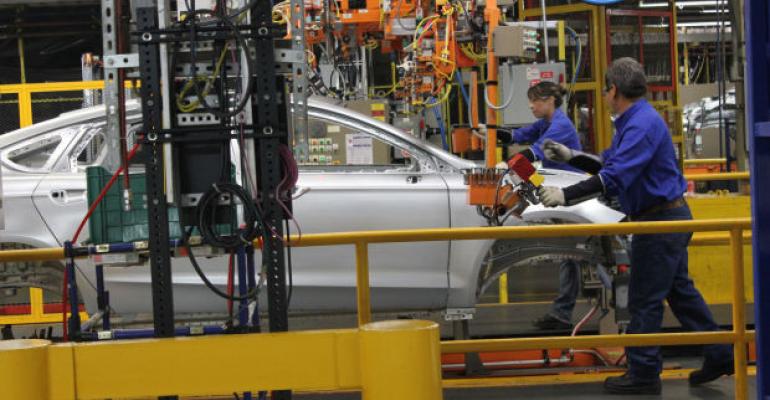WASHINGTON – U.S. automakers are facing tough choices posed by United States-Mexico-Canada Agreement (USMCA) to avoid its pressure on costs being reflected in showroom price increases.
The new deal, which replaced the North American Free Trade Agreement (NAFTA) on July 1, requires U.S., Mexican and Canadian auto manufacturers to increase their USMCA-bloc sourcing to ensure that 75% of a vehicle's parts are made in a signatory country to benefit from the agreement’s free-trade provisions. This is up from 62.5% under NAFTA.
And 40% to 45% of the auto content must be made by workers earning at least $16 per hour.
Kristin Dziczek, vice president-research at the Michigan-based Center for Automotive Research, says U.S. companies need to be particularly careful with the price of smaller cars and sedans, which are both the most price-sensitive categories and profit margins are smallest.
The center says passenger cars comprised 24.1% of 2020 U.S. vehicle sales through October.
Automakers with Mexican operations will “find the lowest-cost way” of complying, she notes. “That’s built into capitalism.”
But how? Automation is one way. Another is simply to ignore the USMCA’s benefits altogether and pay the 2.5% duty currently charged on passenger cars, SUVs and CUVs imported into the U.S., a rate protected by World Trade Organization commitments.
It is possible that manufacturers may think compliance will cost them more than 2.5%. Aside from the labor standards, the USMCA is a more complex agreement than NAFTA, with parts-origin rules covering a wider range of components, and there is also a steel- and aluminium-content rule.
If automakers think compliance, including the cost of administering the agreement, exceeds 2.5% of a vehicle cost, they may just pay the duty. And this would exempt them from commitments to pay higher wages and meet USMCA sourcing requirements.
“You can get a lot of content from Thailand and South Korea,” Dziczek says. The only problem here would be for pickup trucks and cargo vans, where the U.S. duty is 25%, and where the USMCA will make sense regardless.
Also, while the USMCA is designed to push automakers into transferring production back to the U.S., Dziczek says there is evidence manufacturers instead are considering increasing Mexican output.
Ironically, she notes, this could help deliver NAFTA’s largely unfulfilled promise to raise Mexican incomes so that country becomes a solid market for American and Canadian exports.
Alexandre Marian, a San Francisco-based managing director in the automotive and industrial practice at consulting firm AlixPartners, says automakers would be “really working on” the USMCA’s sourcing and labor payment rules.
He predicts they will, one way or another, finesse the deal: “It’s unlikely that dealers, those at the bottom of the chain, will feel a direct impact.
“The labor value content is challenging. It changes the way of thinking about assembly in Mexico versus the U.S. and Canada. It will affect different auto manufacturers differently,” Marian tells Wards.
Jennifer Safavian (below), president and CEO of Autos Drive America, which represents the U.S. operations of international automakers, admits the USMCA is “still a work in progress.” She adds: “There are a lot more requirements and rules. For the auto industry it is a much heavier lift” than for some other industries covered by the USMCA.
 Autos Drive America’s executive vice president, Paul Ryan, says companies already have submitted ‘alternative staging regime’ petitions to the office of the U.S. Trade Representative, requesting more time to comply with the USMCA’s origin requirement. “This is an order of magnitude more complex” than NAFTA, he says.
Autos Drive America’s executive vice president, Paul Ryan, says companies already have submitted ‘alternative staging regime’ petitions to the office of the U.S. Trade Representative, requesting more time to comply with the USMCA’s origin requirement. “This is an order of magnitude more complex” than NAFTA, he says.
Yet, Ryan is optimistic the USMCA’s push for more supplies to be sourced within the three signatory countries will actually deliver, with automakers recognizing “an integrated North American automotive market has been key to the expansion of international automakers’ operations in the United States.”
One problem, says a U.S. dealer who requested anonymity, is the fact automakers are not sharing information on how they plan to manage the USMCA’s demands with regard to future costs and pricing.
“Each automaker has its own unique and confidential plan with respect to the management of its supply chain as they work to implement these new rules,” the dealer says.
Would the potential election of Joe Biden as U.S. president make a difference?
Yes, says Dziczek, if he switched his China policy away from the aggressive bilateral approach favored by Donald Trump to the multilateral strategy favored by his predecessor Barack Obama, whom Biden served as vice president.
A policy cornerstone was the Trans-Pacific Partnership deal seeking to anchor a critical mass of 12 countries to a U.S.-focused trading regime, a strategy Trump abandoned in early 2017.
The other 11 countries went ahead and forged the new bloc anyway – as the Comprehensive and Progressive Agreement for Trans-Pacific Partnership (CPTPP) – and it includes Mexico and Canada.
While the CPTPP has labor protections, they are nowhere near as tough as the USMCA’s. Should the U.S. join the CPTPP, automakers would have another route for sending less-expensive Mexico-made vehicles to the U.S., Dziczek notes.
– with Keith Nuthall in Ottawa





